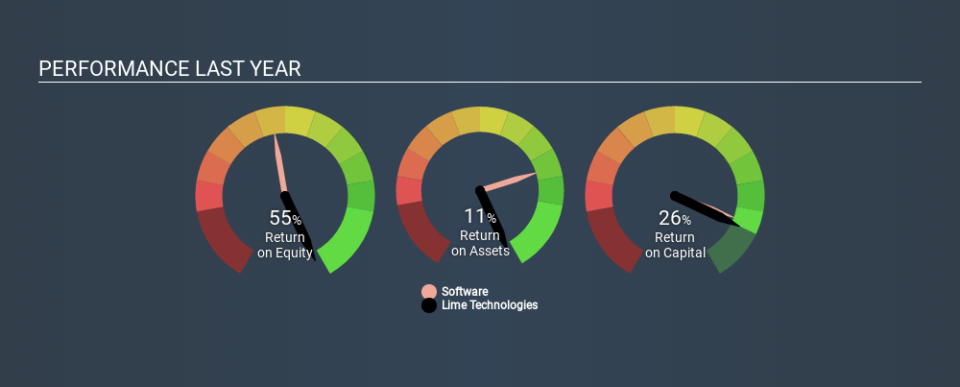Is Lime Technologies AB (publ)’s (STO:LIME) 26% ROCE Any Good?

Today we'll evaluate Lime Technologies AB (publ) (STO:LIME) to determine whether it could have potential as an investment idea. To be precise, we'll consider its Return On Capital Employed (ROCE), as that will inform our view of the quality of the business.
Firstly, we'll go over how we calculate ROCE. Next, we'll compare it to others in its industry. Finally, we'll look at how its current liabilities affect its ROCE.
Return On Capital Employed (ROCE): What is it?
ROCE measures the 'return' (pre-tax profit) a company generates from capital employed in its business. In general, businesses with a higher ROCE are usually better quality. Ultimately, it is a useful but imperfect metric. Author Edwin Whiting says to be careful when comparing the ROCE of different businesses, since 'No two businesses are exactly alike.
How Do You Calculate Return On Capital Employed?
Analysts use this formula to calculate return on capital employed:
Return on Capital Employed = Earnings Before Interest and Tax (EBIT) ÷ (Total Assets - Current Liabilities)
Or for Lime Technologies:
0.26 = kr41m ÷ (kr294m - kr135m) (Based on the trailing twelve months to September 2019.)
Therefore, Lime Technologies has an ROCE of 26%.
See our latest analysis for Lime Technologies
Is Lime Technologies's ROCE Good?
One way to assess ROCE is to compare similar companies. Lime Technologies's ROCE appears to be substantially greater than the 13% average in the Software industry. I think that's good to see, since it implies the company is better than other companies at making the most of its capital. Putting aside its position relative to its industry for now, in absolute terms, Lime Technologies's ROCE is currently very good.
You can click on the image below to see (in greater detail) how Lime Technologies's past growth compares to other companies.
When considering this metric, keep in mind that it is backwards looking, and not necessarily predictive. Companies in cyclical industries can be difficult to understand using ROCE, as returns typically look high during boom times, and low during busts. This is because ROCE only looks at one year, instead of considering returns across a whole cycle. Future performance is what matters, and you can see analyst predictions in our free report on analyst forecasts for the company.
Do Lime Technologies's Current Liabilities Skew Its ROCE?
Current liabilities are short term bills and invoices that need to be paid in 12 months or less. Due to the way ROCE is calculated, a high level of current liabilities makes a company look as though it has less capital employed, and thus can (sometimes unfairly) boost the ROCE. To counteract this, we check if a company has high current liabilities, relative to its total assets.
Lime Technologies has total liabilities of kr135m and total assets of kr294m. Therefore its current liabilities are equivalent to approximately 46% of its total assets. Lime Technologies's ROCE is boosted somewhat by its middling amount of current liabilities.
The Bottom Line On Lime Technologies's ROCE
Even so, it has a great ROCE, and could be an attractive prospect for further research. Lime Technologies looks strong on this analysis, but there are plenty of other companies that could be a good opportunity . Here is a free list of companies growing earnings rapidly.
If you like to buy stocks alongside management, then you might just love this free list of companies. (Hint: insiders have been buying them).
If you spot an error that warrants correction, please contact the editor at editorial-team@simplywallst.com. This article by Simply Wall St is general in nature. It does not constitute a recommendation to buy or sell any stock, and does not take account of your objectives, or your financial situation. Simply Wall St has no position in the stocks mentioned.
We aim to bring you long-term focused research analysis driven by fundamental data. Note that our analysis may not factor in the latest price-sensitive company announcements or qualitative material. Thank you for reading.

